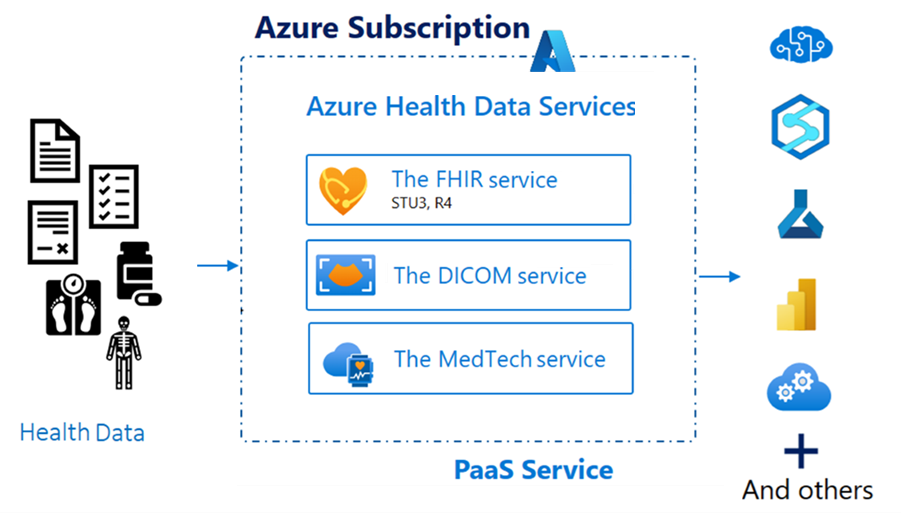Introduction to the DICOM service
The DICOM service is a cloud-based solution that enables healthcare organizations to ingest, store, manage, and exchange medical imaging data securely and efficiently with any DICOM web-enabled systems or applications. The DICOM service is part of What is Azure Health Data Services?.
The service ingests and persists DICOM objects from vendor neutral archives (VNA), picture archiving and communications system (PACS), and other medical imaging systems. Azure Health Data Services DICOM service enables you to store DICOM images in the cloud, where you can query, retrieve, and share medical images with ease.
The DICOM service offers many benefits, including:
Global availability. The DICOM service is available in any of the regions where Azure Health Data Services is available. Microsoft is continuously expanding availability of the DICOM service, so check regional availability for updates.
PHI compliance. The DICOM service is designed for protected health information (PHI), meeting all regional compliance requirements including Health Insurance Portability and Accountability Act (HIPAA), General Data Protection Regulation (GDPR), and California Consumer Privacy Act (CCPA).
Scalability. The DICOM service scales to support everything from small imaging archives in a clinic to large imaging archives with petabytes of data and thousands of new studies added daily.
Automatic data replication. The DICOM service uses Azure Locally Redundant Storage (LRS) within a region. If one copy of the data fails or becomes unavailable, your data can be accessed without interruption.
Role-based access control (RBAC). RBAC enables you to manage how your organization's data is stored and accessed. You determine who has access to datasets based on roles you define for your environment.
Healthcare scenarios
To effectively treat patients, research treatments, diagnose illnesses, or get an overview of a patient's health history, organizations need to integrate data across several sources. The DICOM service enables imaging data to persist in the Microsoft cloud and allows it to reside with electronic health records (EHR) and healthcare device (IoT) data in the same Azure subscription.
The DICOM service supports the following capabilities:
Image back-up. Research institutions, clinics, imaging centers, veterinary clinics, pathology institutions, retailers, or other healthcare organizations can use the DICOM service to back up their images with unlimited storage and access. There's no need to de-identify PHI data because the service is validated for PHI compliance.
Image exchange and collaboration. Share an image, a subset of images, or an entire image library instantly with or without related EHR data.
Integrate with clinical data - Store references to image data in FHIR, if used, to help query across clinical and imaging datasets.
Create cohorts for research. To find the right patients for clinical trials, researchers need to query for patients that match data in both clinical and imaging systems. The service allows researchers to use natural language to query across systems. For example, “Give me all the medications prescribed with all the CT scan documents and their associated radiology reports for any patient older than 45 that has a diagnosis of osteosarcoma over the last two years.”
Plan treatment based on similar patients. When presented with a patient diagnosis, a physician can identify patient outcomes and treatment plans for past patients with a similar diagnosis even when these include imaging data.
Get a longitudinal view of a patient during diagnosis. Radiologists, especially teleradiologists, often don't have complete access to a patient’s medical history and related imaging studies. Through FHIR integration, this data can be provided even to radiologists.
Enable teleradiology workflows. Teleradiologist can make better recommendations by integrating with the cloud PACS and Zero Footprint Viewers.
With limited or no access to clinical results or outcomes, they miss opportunities to improve their skills. Through integration with FHIR, an organization can create a tool that provides direct feedback to teleradiologists, helping them make better recommendations in the future.
Key capabilities
The DICOM service enables organizations to manage medical imaging data with several key capabilities:
Data isolation - The DICOM service assigns a unique database to each service instance, which means your organization's data isn't mixed with other organizations' data. The DICOM service also supports optional data partitions to create more separation for multiple tenants within a single instance.
Studies Service support - The Studies Service allows users to store, retrieve, and search for DICOM studies, series, and instances. Microsoft includes the nonstandard delete transaction to enable a full resource lifecycle.
Worklist Service support - The DICOM service supports the Push and Pull SOPs of the Worklist Service (UPS-RS). This service provides access to one Worklist containing Workitems, each of which represents a Unified Procedure Step (UPS).
Extended query tags - The DICOM service allows you to customize the list of tags in the index extending beyond the default list specified in the DICOM Conformance Statement. You can index DICOM studies, series, and instances on standard or private DICOM tags.
Change feed - The DICOM service enables you to access ordered, guaranteed, immutable, read-only logs of all changes that occur in the DICOM service. Client applications can read these logs at any time independently, in parallel and at their own pace.
DICOMweb APIs - The DICOMweb compliant REST APIs enable the integration with the DICOM ecosystem of tools such as ZFVs and PACS or VNA systems.
Integration with Azure Data Lake storage - The integration of the DICOM service with Azure Data Lake Storage provides cloud-scale storage to manage imaging data with flexibility through Azure storage ecosystem and APIs. This helps unlock new analytics and AI/ML scenarios by using services that natively integrate with Azure Data Lake Storage, including Azure Synapse, Azure Databricks, Azure Machine Learning, and Microsoft Fabric. For more information, see Manage medical imaging data with the DICOM service and Azure Data Lake Storage
Export files. The DICOM service allows you to export DICOM data in the standard DCM format(part 10), simplifying the process of using medical imaging in external workflows such as AI and machine learning.
